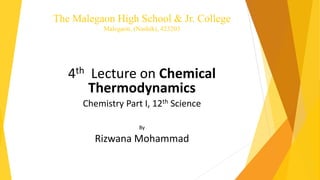
4th Lecture on Chemical Thermodynamics | Chemistry Part I | 12th Std
- 1. The Malegaon High School & Jr. College Malegaon, (Nashik), 423203 4th Lecture on Chemical Thermodynamics Chemistry Part I, 12th Science By Rizwana Mohammad
- 2. Spontaneous (irreversible) process: Spontaneous process have a natural tendency to occur and do not require any external influence for their occurrence. ”The spontaneous (natural) processes tend to occur in a direction that leads to equilibrium.” Energy and spontaneity: The spontaneous reaction takes place in a direction in which energy of the system is lowered. It is accompanied by release of energy. The reaction between NaOH and HCl is exothermic (ΔrH˚ = -57 kJ) and is spontaneous. On the other hand: i. Ice melts spontaneously by absorbing heat from surrounding. ii. NaCl dissolves spontaneously by absorption of heat These are endothermic and spontaneous. Therefore, exothermicity is not the sufficient criterion for spontaneity. There must be another factor to describe spontaneity.
- 3. Entropy: Consider following figure During melting of ice or the vaporization of liquid water the disorder or randomness increases. The disorder or randomness is measured by entropy, denoted by S. During above two processes, entropy change ΔS > 0 e.g. i. Dissolution of solid I2 in water I2(s) + aq. → I2(aq); ΔS is positive ordered state disordered state ii. Dissociation of H2 molecule into atoms H2(g) → 2H(g); ΔS is positive disordered state highly disordered state
- 4. Quantitative definition of entropy: Entropy change of a system is equal to the amount of heat transferred (Qrev) to it in a reversible manner divided by the temperature in Kelvin. Thus, ΔS = 𝑄 𝑟𝑒𝑣 𝑇 ΔS is expressed in JK-1 i. ΔS is directly proportional to Qrev ii. ΔS is inversely proportional to T Entropy and spontaneity: Look at following examples: i. The entropy increases when ice melts above 0°c and water vaporizes at 100°c. Both are so spontaneous. ii. Consider the spontaneous reaction at room temperature 2H2O2(l) → 2H2O(l) + O2(g); ΔS = +126 JK-1 In the above examples, entropy of the system increases in the spontaneous process. Consider the reaction 2H2(g) + O2(g) → 2H20(l); ΔS = - 327 JK-1 The entropy of the system decreases, yet the reaction is spontaneous.
- 5. Second law of thermodynamics: "The second law of thermodynamics states that total entropy of a system and its surroundings increases in a spontaneous process” i.e. ΔStotal = ΔSsys + ΔSsurr > 0 Consider, 2H2(g) + O2(g) → 2H₂O(l) at 298 k. ΔS = -327 JK-1, ΔH = -572 kJ ΔSsurr = 𝑄 𝑟𝑒𝑣 𝑇 = 572 ∗103 𝐽 298 𝑘 = 1919 Jk-1 Δstotal = ΔSsys + ΔSsurr = -327 + 1919 = +1592 Jk-1 therefore ΔStotal > 0 The reaction is thus spontaneous. It follows that to decide spontaneity of reactions, we need to consider the entropy of system and its surrounding. Thus, i. ΔStotal > 0, process is spontaneous, ii. ΔStotal < 0, process is nonspontaneous, iii. ΔStotal = 0, process is at equilibrium.
- 6. Gibbs energy: The Gibbs energy is defined as G = H –TS …1 ΔG = ΔH – TΔS …2 Gibbs energy and spontaneity: The total entropy change is given by ΔStotal = ΔSsys + ΔSsurr = ΔS + ΔSsurr …3 Relation between ΔG and ΔStotal: According to second law of thermodynamics for a process to be spontaneous, ΔStotal > 0 If ΔH is enthalpy change of system, -ΔH is enthalpy change of surrounding. ΔSsurr = − Δ 𝐻 𝑇 From eqn 3 ΔStotal = ΔS - Δ𝐻 𝑇 …4 -TΔStotal = ΔH – TΔS …5 Comparing eqn 2 & 5 ΔG = -TΔStotal Thus, i. ΔStotal > 0 and ΔG < 0, process is spontaneous, ii. ΔStotal < 0, ΔG > 0, process is non spontaneous, iii. ΔStotal = 0, ΔG = 0, process is at equilibrium.
- 7. From ΔG = ΔH - T ΔS (at constant T and P). The temperature term determines relative contributions of ΔH and ΔS to ΔG. 1. ΔH and ΔS are both negative then ΔG will be negative only when ΔH is more negative than TΔS. This is possible at low temperatures only. 2. ΔH and ΔS both positive ΔG will be negative only if TΔS > ΔH. This is possible only at high temperatures. 3. For ΔH negative and ΔS is positive it follows that ΔG is negative regardless of temperature. 4. For ΔH positive and ΔS is negative then ΔG is positive regardless of temperature. Such reactions are nonspontaneous at all temperatures. ΔH ΔS ΔG Spontaneity of reactions - (exothermic) + - Reactions are spontaneous at all temperatures. - (exothermic) - - Reactions become spontaneous at low temperatures when | T. ΔS | < |ΔH| + (endothermic) + - Reactions become spontaneous at high temperatures when T. ΔS > ΔH + (endothermic) - + Reactions are nonspontaneous at all temperatures. Spontaneity and ΔH or ΔS:
- 8. Temperature of equilibrium: ΔG = ΔH – TΔS For equilibrium, ΔG = 0 T = ΔH ΔS T is the temperature at which the change over from spontaneous to non spontaneous behaviour occurs. Gibbs function and equilibrium constant: Gibbs energy change for a chemical reaction is given by ΔG = ΔG˚ + RT lnQ ΔG˚ = standard Gibbs energy change, Q = reaction quotient. Consider aA + bB ⇌ cC + dD ΔG = ΔG˚ + RT lnQc = ΔG˚ + RT ln 𝐶 𝑐 𝐷 𝑑 𝐴 𝑎 𝐵 𝑏 Or ΔG = ΔG˚ + RT lnQp = ΔG˚ + RT ln 𝑃 𝑐 𝐶 ∗𝑃 𝑑 𝐷 𝑃 𝑎 𝐴 ∗𝑃 𝑏 𝐵
- 9. When the reaction reaches equilibrium, ΔG=0 Qc = Kc, Qp = Kp 0 = ΔG˚ + RT lnKc and 0 = ΔG˚ + RT lnKp Or ΔG˚ = -RT lnkc and ΔG˚ = -RT lnkp Or ΔG˚ = -2.303 RT log10Kc and ΔG˚ = -2.303 RT log10Kp
